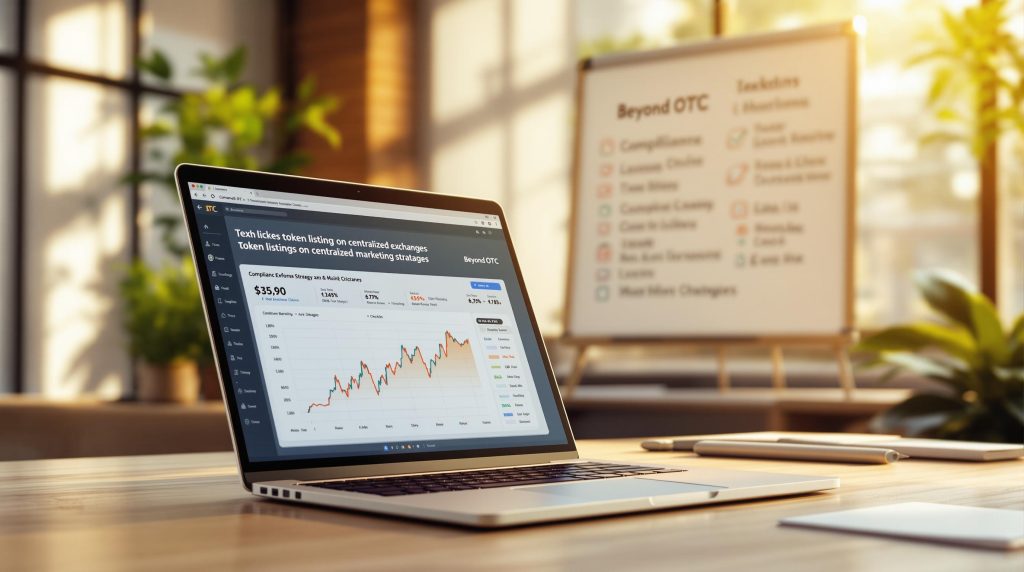OTC crypto trading offers privacy and flexibility for large transactions, but it’s highly exposed to macroeconomic risks like inflation, interest rate changes, and geopolitical events. These risks can disrupt liquidity, increase counterparty defaults, and magnify market volatility. Understanding how OTC trading compares to centralized (CEXs) and decentralized exchanges (DEXs) can help traders navigate these challenges.
Key Takeaways:
- OTC Trading: Ideal for large trades but faces liquidity issues and counterparty risks during economic instability.
- CEXs: Transparent with high liquidity but vulnerable to regulatory actions and withdrawal freezes.
- DEXs: Transparent and decentralized, but liquidity dries up quickly in volatile periods.
Quick Comparison:
| Feature | OTC Trading | CEXs | DEXs |
|---|---|---|---|
| Liquidity | High, but fragile | High, but fluctuates | Medium, highly volatile |
| Counterparty Risk | High | Medium | Low |
| Transparency | Low | Medium | High |
| Macroeconomic Sensitivity | Medium | High | High |
OTC trading requires robust risk management strategies, including diversified liquidity sources, legal compliance, and reliable market intelligence. Platforms like BeyondOTC help traders mitigate these risks by connecting them to strong OTC networks, offering real-time insights, and ensuring compliance during economic uncertainty.
How Can You Avoid Crypto OTC Counterparty Risk? – All About Crypto Exchanges
1. OTC Crypto Trading
OTC crypto trading operates in a unique space, but it faces significant hurdles when macroeconomic pressures arise. Let’s dive into four key areas where these challenges come to light.
Liquidity and Slippage
OTC desks are designed to handle large trades by pooling liquidity, aiming to execute transactions with minimal impact on the market. However, this advantage can quickly disappear in times of economic stress. Take the 2022 crypto market downturn as an example – it was driven by aggressive Federal Reserve interest rate hikes and inflation concerns. During this period, many OTC desks faced severe liquidity shortages. Liquidity sources dried up almost overnight, leading to wider spreads and increased slippage, even for trades typically structured to avoid such issues. When liquidity is squeezed, the reliance on counterparties becomes an even riskier proposition.
Counterparty Risk
Counterparty risk is a major concern in OTC crypto trading, especially during volatile economic periods. These trades rely entirely on the creditworthiness of the counterparty, and this dependence becomes more precarious during downturns.
Macroeconomic shocks can lead to widespread defaults among counterparties. In some extreme cases, OTC providers have frozen withdrawals or failed to settle trades altogether, leaving clients with significant losses. The interconnected nature of the crypto ecosystem makes this issue even more severe. Stress within one major player can ripple through the system, affecting others that rely on the same liquidity pools or settlement channels. Adding to the complexity is the private nature of OTC markets, which often lack the transparency needed to quickly identify and mitigate such risks.
Market Transparency
One of the defining features of OTC trading is its lack of transparency, which can be both an asset and a liability during uncertain times. While the privacy it offers is appealing for large trades, the absence of public order books makes accurate price discovery more difficult.
This opacity can hide systemic risks until they escalate. For instance, during the Russia-Ukraine conflict, OTC trading volumes spiked as investors discreetly moved large sums of capital. However, the lack of transparency made it nearly impossible to assess the broader impact on market stability. Without clear data, it becomes harder to determine whether OTC prices reflect true market conditions or are skewed by temporary dislocations caused by liquidity or counterparty issues. This information gap can lead to poor decision-making, especially when timely and accurate market intelligence is most critical.
Macroeconomic Sensitivity
OTC crypto trading is particularly sensitive to macroeconomic trends because it primarily caters to institutional investors and high-net-worth individuals. These groups frequently adjust their portfolios in response to shifting economic conditions. This creates a dynamic environment where opportunities and risks can emerge quickly.
For example, inflation spikes or geopolitical instability often drive institutions to make large, discreet crypto trades as they seek alternative stores of value. On the flip side, recession fears or tighter monetary policies tend to reduce risk appetite, leading to lower trading volumes and greater caution among participants. Key economic indicators like Federal Reserve policy announcements, inflation reports, or major geopolitical events can instantly reshape OTC market activity.
Institutional trading through OTC desks also amplifies the effects of macroeconomic shocks. When large players like hedge funds, pension funds, or corporate treasuries adjust their crypto allocations based on economic forecasts, their actions can significantly heighten market volatility.
2. Centralized Exchanges (CEXs)
Centralized exchanges (CEXs) operate differently from OTC trading, facing their own set of challenges due to their public order books and centralized structure.
Liquidity and Slippage
Under normal conditions, CEXs like Coinbase and Binance maintain high liquidity through active market-making. However, during periods of economic turbulence, such as the rapid interest rate hikes of 2022 and 2023, liquidity on these platforms often dries up, leading to significant slippage – especially for altcoins. A similar trend was observed during the 2020 COVID-19 market crash, when record trading volumes were accompanied by sharp slippage and occasional delays in withdrawals. These liquidity issues highlight the vulnerabilities of centralized models during times of macroeconomic stress, creating unique risks for traders.
Counterparty Risk
When using centralized exchanges, traders rely on the platform to securely hold their assets and execute transactions. Unlike OTC trading, where risk is shared between two parties, CEX users face centralized counterparty risks. These risks become particularly pronounced during economic downturns, recessions, or periods of heightened regulatory scrutiny, as they can lead to insolvency or operational failures. Leading exchanges mitigate these risks through strict security measures and regulatory compliance. Even so, during uncertain times, traders must practice increased due diligence and manage their assets carefully.
Market Transparency
CEXs are known for their high level of market transparency. Features like real-time order books, detailed trade histories, and continuous price feeds give traders valuable insights into market depth and order flow. However, this transparency can also amplify market volatility. For example, during the 2023 U.S. banking crisis, mass stablecoin outflows triggered sharp price fluctuations as traders reacted to market shifts. While transparency provides critical real-time data, it can also lead to rapid and sometimes extreme market adjustments when economic conditions change.
Macroeconomic Sensitivity
The operations of CEXs have become increasingly tied to global economic conditions. The rise of institutional investors and crypto ETFs has deepened the connection between these exchanges and traditional financial markets. Key macroeconomic factors such as inflation, interest rates, and Federal Reserve policies directly influence trading activity. For instance, rising inflation often drives up trading volumes, while higher interest rates tend to curb risk-taking. In extreme cases of economic stress, some exchanges have even halted trading, exacerbating market volatility and trader losses. Additionally, factors like U.S. dollar strength and global economic sentiment play a crucial role in shaping asset flows and overall market behavior.
3. Decentralized Exchanges (DEXs)
Decentralized exchanges (DEXs) operate without intermediaries, relying instead on automated market makers (AMMs) and liquidity pools. While this structure offers certain advantages, it also introduces vulnerabilities, especially during periods of economic uncertainty when macroeconomic conditions shift.
Liquidity and Slippage
Liquidity can dry up quickly for DEXs during times of macroeconomic stress. When the Federal Reserve tightens monetary policy or inflation spikes, investors often pull out of riskier assets, causing liquidity in DEX pools to dwindle rapidly. This lack of liquidity leads to higher slippage – essentially, the price difference between what a trader expects and the actual transaction price.
Take the March 2020 COVID-19 market crash as an example: Uniswap experienced a surge in trading volume, but liquidity providers withdrew their funds, resulting in a sharp drop in total value locked (TVL) and significant slippage. A similar pattern unfolded in 2022 when interest rate hikes caused liquidity to evaporate, triggering a feedback loop of capital withdrawals and heightened slippage. While liquidity challenges are a major concern, DEXs shift the focus from traditional counterparty risks to vulnerabilities in smart contracts due to their non-custodial design.
Counterparty Risk
One of the key advantages of DEXs is the elimination of centralized counterparty risk. Users retain control of their assets through smart contracts, reducing reliance on intermediaries. However, during periods of economic stress, these smart contracts can become a target for exploitation. For instance, the 2022 market downturn exposed weaknesses in several DeFi protocols, leading to liquidity crises and various exploits.
Market Transparency
DEXs stand out for their transparency. Every transaction is recorded on public blockchains, allowing real-time monitoring of liquidity pools, trading volumes, and price changes. This transparency becomes particularly valuable during macroeconomic shocks. During the March 2020 market turmoil, on-chain data enabled analysts to track liquidity outflows and slippage events as they happened. Traders can leverage this visibility to make more informed decisions about when to enter or exit positions – something that is far less feasible with opaque over-the-counter (OTC) trades.
Macroeconomic Sensitivity
DEXs are highly reactive to macroeconomic shifts, responding almost immediately to changes in policy or economic events. Unlike centralized platforms, which often have mechanisms like circuit breakers to stabilize trading, DEXs operate without such buffers. As crypto assets become more intertwined with traditional markets, their sensitivity to macroeconomic changes has only increased.
For example, the 2021 bull market, driven by loose monetary policy, fueled significant growth in DEX activity and TVL. Conversely, tightening monetary conditions have consistently led to reduced trading volumes and liquidity. Institutional investors now closely watch DEX activity as a gauge for market sentiment and broader economic risks. Events such as Federal Reserve policy announcements, inflation reports, or geopolitical tensions often result in immediate shifts in DEX trading volumes and volatility. This heightened sensitivity means traders must stay alert, as DEXs can amplify market movements rather than buffer them. These dynamics highlight both the challenges and the opportunities that DEX trading presents compared to OTC and centralized platforms.
sbb-itb-7e716c2
Advantages and Disadvantages Comparison
When navigating macroeconomic pressures, understanding how different trading methods respond can help traders make smarter decisions about where to execute their transactions. Each platform comes with its own set of risks and rewards, which become even more pronounced during economic stress. This comparison sheds light on those differences and highlights how BeyondOTC fits into the broader picture of managing such risks.
OTC trading is often favored for large trades due to its ability to limit market impact. However, it comes with drawbacks like higher counterparty risk and limited transparency. Under economic stress, OTC desks often face reduced liquidity and longer settlement times as counterparties grow more cautious.
Centralized exchanges, on the other hand, feature deep liquidity and user-friendly interfaces, making them appealing for a wide range of traders. Yet, they are not without flaws. These platforms can be vulnerable to regulatory actions, sudden capital outflows, and, in times of crisis, withdrawal freezes that disrupt trading activity.
Decentralized exchanges stand out for their transparency and reduced counterparty risk, thanks to smart contracts. But they often struggle with liquidity issues, especially during times of economic uncertainty. For instance, the market downturn in 2022 showed how quickly liquidity on decentralized platforms can dry up when providers pull their funds.
This breakdown underscores the importance of macroeconomic forces in shaping trading decisions. Each platform reacts differently to such pressures, influencing the strategies traders use.
| Feature | OTC Trading | Centralized Exchanges (CEXs) | Decentralized Exchanges (DEXs) |
|---|---|---|---|
| Liquidity | High | High | Medium |
| Counterparty Risk | High | Medium | Low |
| Transparency | Low | Medium | High |
| Macroeconomic Sensitivity | Medium | High | High |
Macroeconomic sensitivity plays out differently across these platforms. OTC markets, often the go-to for institutional players, are less reactive to sudden economic news but can still influence broader market trends through large transactions. Meanwhile, centralized and decentralized platforms, with their higher retail participation and automated trading, tend to experience sharper short-term volatility during economic shifts.
Regulation adds another layer of complexity. OTC trading often operates in a gray area with inconsistent rules across jurisdictions, making it riskier during policy changes. Centralized exchanges, governed by stricter Know Your Customer (KYC) and Anti-Money Laundering (AML) requirements, are more directly impacted by regulatory shifts. Decentralized exchanges, while less regulated, face challenges from evolving legal frameworks and enforcement actions, particularly in unstable economic climates.
Ultimately, the choice between these platforms hinges on factors like trade size and risk appetite. Institutional traders handling large transactions may lean toward OTC markets despite the counterparty risks, while retail traders often prefer centralized exchanges for their liquidity and ease of use. Meanwhile, decentralized platforms attract users who value self-custody and transparency, even if it means dealing with liquidity limitations and technical risks.
How BeyondOTC Helps Manage Macroeconomic Risks

Macroeconomic risks in OTC crypto trading go beyond just understanding market trends. They require access to reliable networks, compliance expertise, and strong infrastructure. BeyondOTC steps in as a crucial connector, offering tailored solutions to help clients navigate economic uncertainties. Here’s how BeyondOTC addresses these challenges with its comprehensive approach.
Access to Institutional-Grade Liquidity
One of the key challenges during volatile economic periods is maintaining liquidity. BeyondOTC links clients to institutional OTC desks known for their strong risk management practices and deep liquidity reserves. This connection becomes especially critical during liquidity crunches, when traditional trading platforms might face settlement delays or reduced capacity.
For instance, during periods of rising U.S. interest rates that heightened market volatility, BeyondOTC facilitated access to top-tier OTC desks. These desks provided hedging strategies and stablecoin liquidity, helping clients reduce exposure to price fluctuations and maintain operational stability during turbulent times.
Global Network Diversification
BeyondOTC takes risk management a step further by leveraging a geographically diverse network. Spanning over 50 countries, this network connects clients with investors, traders, and financial institutions across various economic zones. This global reach helps mitigate risks tied to localized economic downturns or regulatory changes.
For example, when the correlation between crypto and traditional equities hit 0.86 in 2025, having access to diverse liquidity sources became essential. BeyondOTC’s network enables seamless cross-border transactions in multiple currencies, making it easier for clients to navigate different regulatory environments and economic conditions.
Regulatory Compliance Support
The ever-changing regulatory landscape, particularly in the U.S., demands specialized knowledge. BeyondOTC provides access to legal consultancy services that focus on blockchain and cryptocurrency regulations. These services guide clients through compliance requirements like Know Your Customer (KYC) and Anti-Money Laundering (AML) protocols, reducing exposure to legal and financial risks tied to regulatory shifts.
Real-Time Market Intelligence
To stay ahead in a dynamic economic environment, real-time insights are essential. BeyondOTC offers clients access to real-time market data, macroeconomic reports, and analytical tools that track key indicators such as inflation, interest rates, and geopolitical events.
This service proved invaluable in Q3 2025, when Federal Reserve rate cuts spurred a 6% increase in Bitcoin via ETFs while also amplifying volatility in other sectors. Armed with these insights, clients can make informed decisions quickly.
Risk Management Strategies
BeyondOTC emphasizes the importance of diversification and security in managing macroeconomic risks. It advises clients to diversify their portfolios, use escrow and third-party custodians for secure settlements, and leverage technical analysis tools to identify the best entry and exit points. Additionally, its fundraising advisory services connect clients with new capital sources and market opportunities, helping them adapt to shifting economic conditions.
24/7 Support During Crisis Periods
Economic crises don’t follow a 9-to-5 schedule, and neither does BeyondOTC. The platform offers 24/7 trading support to ensure clients have continuous assistance during rapidly changing market conditions. This around-the-clock support was especially critical during the October 2025 flash crash sparked by U.S.-China trade tensions and Federal Reserve rate cuts.
Conclusion
The analysis makes it clear: macroeconomic risks touch every corner of cryptocurrency trading, regardless of the method. Each approach comes with its own set of challenges. OTC trading, for instance, provides privacy and minimizes market impact, but it’s not immune to counterparty and liquidity risks, especially during times of economic instability.
Centralized exchanges stand out for their transparency and quick settlements, but they’re highly susceptible to regulatory pressures and market-wide volatility. On the other hand, decentralized exchanges offer censorship resistance and global accessibility but can face liquidity issues when market conditions take a turn for the worse. These unique vulnerabilities highlight the importance of strong, proactive risk management strategies.
To navigate these risks, traders and institutions should spread their activities across multiple trading methods and counterparties while adhering to rigorous due diligence processes. During volatile periods, using verified OTC providers that include escrow or third-party custodians can make a significant difference. The October 2025 flash crash – triggered by U.S.-China trade tensions and Federal Reserve rate cuts – served as a stark reminder of the need for 24/7 support and adaptable trading strategies. Keeping a close eye on key indicators, staying compliant with evolving KYC/AML requirements, and preparing for potential asset freezes are all critical steps for building agile and compliant trading frameworks. Additionally, the shift in global economic power, reflected by the U.S. dollar’s declining share in global central bank reserves (from 71% in 2000 to 57.7% in 2025), is another factor that crypto traders must account for.
BeyondOTC exemplifies how to address these challenges, offering services that connect clients with reliable OTC desks, provide legal guidance, and grant access to a global network. Their approach underscores the importance of diversification, constant monitoring, and compliance in managing macroeconomic risks.
As Bitcoin stabilizes in the $110,000–$120,000 range despite ongoing economic challenges, it’s clear that sophisticated risk management is no longer optional – it’s essential. Success in OTC crypto trading hinges on precise timing, robust infrastructure, and the ability to adapt to shifting conditions. Institutions that prioritize counterparty due diligence, flexible strategies, and partnerships with trusted networks will be best positioned to thrive in this unpredictable landscape.
FAQs
How do macroeconomic factors like interest rate changes and inflation affect liquidity in OTC cryptocurrency trading?
Macroeconomic elements like interest rate fluctuations and inflation play a crucial role in shaping liquidity within OTC cryptocurrency trading. When interest rates climb, borrowing becomes more expensive, which can shrink market liquidity. This is because traders and institutions face higher costs to secure the capital needed for substantial transactions. On the other hand, soaring inflation diminishes the purchasing power of fiat currencies, often pushing investors to reevaluate their crypto portfolios or shift toward other assets.
In the OTC trading space, known for handling large-volume deals, these economic shifts can affect both the availability of trading counterparties and pricing trends. For instance, during times of economic instability, some institutional investors may adopt a more cautious approach, tightening liquidity across the market.
How does counterparty risk differ between OTC cryptocurrency trading and centralized exchanges during economic downturns?
In times of economic uncertainty, OTC cryptocurrency trading and centralized exchanges (CEXs) manage counterparty risk in distinct ways, largely due to their structural differences. OTC trading involves private, negotiated transactions directly between parties or facilitated by a broker. This setup can shield traders from broader market disruptions, but the level of risk hinges on the trustworthiness and track record of the counterparty or broker.
On the other hand, centralized exchanges serve as intermediaries, holding funds during transactions. While this arrangement simplifies trading, it also brings added risks, such as potential exchange insolvency or security breaches – risks that may be heightened during economic downturns. For traders, grasping these differences is key to tailoring risk management strategies to their specific goals and the prevailing market environment.
How does transparency in OTC crypto trading impact decision-making during periods of market volatility?
Transparency in OTC crypto trading presents both opportunities and challenges, particularly when the market is experiencing sharp fluctuations. On the positive side, increased transparency fosters trust by ensuring all parties have access to essential details, like pricing and trade execution. This level of openness can empower investors to make better-informed choices, while also minimizing the chances of hidden costs or unethical practices.
However, there’s another side to consider. Too much transparency can inadvertently reveal sensitive trading strategies or expose the size of large transactions, which might sway market sentiment and lead to unintended price swings. In volatile markets, this creates a tricky balancing act for traders: they must weigh the benefits of openness against the risks of disclosing their positions. Finding this balance is crucial to maintaining trust while preserving the flexibility needed for effective strategy execution in OTC trading.




